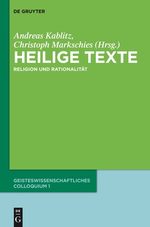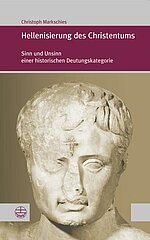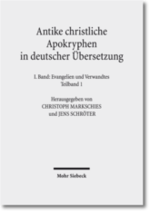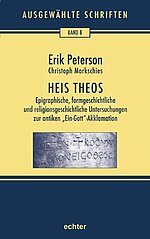Publications récentes
Prokop von Gaza: Eclogarum in libros historicos Veteris Testamenti epitome, Teil 1: Der Genesiskommentar
Prokop von Gaza (ca. 465/470-526/530) verfasste einen großen Kommentar zu den meisten Geschichtsbüchern des Alten Testaments (CPG 7430, bisher fälschlich als Catena in Octateuchum oder Catena in Heptateuchum bezeichnet). Hier wird die kritische Edition des ersten Teil, des Genesiskommentars, vorgelegt; sie enthält zum ersten Mal den vollständigen griechischen Text.
Hinter dem fortlaufenden Texts Prokops verbirgt sich eine Sammlung von Exzerpten aus der Bibelexegese der griechischen Kirchenväter, die man zu seiner Zeit für die gültige Auslegung des Alten Testaments hielt. Besonderen Quellenwert haben diejenigen Exzerpte, für die sich in der uns erhaltenen Überlieferung keine Vorlage, oft nicht einmal der Name des Autors, identifizieren lässt; hier verbergen sich Fragmente, die in ihrer vollständigen Fassung verloren gegangen sind, sei es, weil ihre Verfasser auf späteren Konzilien zu Ketzern erklärt wurden, sei es, weil (gerade bei orientalischen Autoren) die vollständigen Handschriften während der arabischen Eroberung verloren gingen. Das Werk ist daher eine wichtige Quelle für alle, die sich mit der Älteren Kirchengeschichte oder die Exegese des Alten Testaments beschäftigen.
Die mit Anmerkungen versehene deutsche Übersetzung der Editorin wird in Kürze in einer neuen Unterreihe der „Griechischen christlichen Schriftsteller“ erscheinen.
Heilige Texte (Sacred Texts)
Heilige Texte: Religion und Rationalität, 1. Geisteswissenschaftliches Colloquium 10.-13. Dezember 2009 auf Schloss Genshagen. Hg. Andreas Kablitz und Christoph Markschies, Berlin, Boston: De Gruyter, 2013.
The complex relationship between religion and rationality here is based on a
Diversity of Holy texts examined, a medium that a classification
suggests of religion in rational contexts. In addition to writings
of Judaism, Christianity and Islam are spells and myths
at times excessive religious texts such as the Marxism, philosophical
Texts of the Enlightenment and other media such as the modern image of religious Treated contents. Instead of a counter-rotation of rationality and religion it is clear that rationality an important role for the development
of religion and its internal differentiations plays. Dealing with
Sacred texts shows the voltage of wealth in a particular subject
Example: Sacred Texts always have the option of withdrawing from the
rational access with reference to its transcendental dimension.
At the same time proves the religion manifested in the Holy text in the interaction with this access in existence and with it the authority of their
Validity claim over and over again.
Hellenisierung des Christentums
Markschies, Christoph, Hellenisierung des Christentums: Sinn und Unsinn einer historischen Deutungskategorie. Theologische Literaturzeitung. Forum 25. Leipzig: Evangelische Verlagsanstalt, 2012.
„L'Hellénisation du christianisme“ n'est pas seulement une des catégories centrales de l'historien de l'Eglise et organisateur de sciences de Berlin célèbre Adolf von Harnack (1851-1930) pour décrire la formation du christianisme antique. Comme le montre, par exemple, le discours controversé du pape Benoît XVI tenue à Regensburg en 2006, cette catégorie joue un rôle crucial dans les conceptions theólogiques et historiques du christianisme. Le plus souvent, une transformation du christianisme par la culture hellénistique-romaine dans l'Empire romain „mondialisé“ est désignée par ce terme.
Christoph Markschies analyse l'histoire de ce terme et des très différentes définitions et conceptions y liées, informe sur les préhistoires en partie complètement oublies (dans l'humanisme français de la renaissance par exemple) et propose finalement comment ce terme peut être employé aujourd'hui de manière raisonnable malgré une préhistoire non sans problèmes.
Antike christliche Apokryphen in deutscher Übersetzung (Ancient Christian Apocrypha in German translation)
Antike christliche Apokryphen in deutscher Übersetzung. 1. Bd. Evangelien und Verwandtes. Hg. Christoph Markschies und Jens Schröter in Verbindung mit Andreas Heiser. 7. Aufl. Tübingen: Mohr Siebeck, 2012.
"Apocrypha" are texts that have the form had become canonical biblical writings or tell stories about characters that have become canonical biblical writings or words provide such figures. They are an expression of Christian piety and theology have influenced the visual arts as deep.
The best-known German collection of this material is the issue at hand in 1904 published the "New Testament Apocrypha", which goes back to Edgar Hennecke (1865-1951) and then of William Schneemelcher (1914-2003) was published. They will appear in a completely neubearbeiteten and supplemented by many texts seventh edition and includes all non-canonical gospel literature and has become akin from antiquity, and new texts from the Islamic tradition, the Gospel of Judas and the Unknown Berlin Gospel. As there are the writings that refer to the canonical New Testament has become, is difficult to isolate from the Christian Apocrypha, the plant will now include all the Christian Apocrypha until the eighth century. Therefore, it is entitled "Ancient Christian Apocrypha in German translation" (AcA) and published in three volumes.
With contributions from:
Hans-Gebhard Bethge, Wolfgang A. Bienert, Johanna Brankaer, Bogdan Burtea, Friedmann Eissler, Hans Förster, Jörg Frey, Wolf-Peter Funk, Peter Gemeinhardt, Judith Hartenstein, Otfried Hofius, Mary, Joshua, Ursula Ulrike Kaiser, Thomas J. Kraus Christoph Markschies, Helmut Merkel, C. Detlef G. Müller (+), Peter Nagel, Tobias Nicklas, Silvia Pellegrini, Silke Petersen, Uwe-Karsten Plish, Stanley E. Porter, Wendy J. Porter, Siegfried G. Richter, Monika Schärtl, Hans-Martin Schenke (+), Jens Schröter, Josef Tropper, Mark Vincent, Jennifer Wasmuth, Ansgar usury penny, Gregor Wurst.
Heis Theos
Peterson, Erik, Christoph Markschies und Barbara Nichtweiß, Heis Theos: Epigraphische, formgeschichtliche und religionsgeschichtliche Untersuchungen zur antiken "Ein-Gott"-Akklamation. Ausgewählte Schriften Erik Peterson Bd. 8. Würzburg: Echter, 2012.
Erik Peterson's studies on the ancient formula "One God" are since they appeared in 1926, the standard work on the subject of "acclamation". Also for the monotheism research and the problem area is a political theology "Heis Theos" to this day is important.
86 years after the publication of the dissertation and habilitation Peterson's this for many decades out of print work is now back in its original version available
Christoph Markschies, Henrik Hildebrandt inter alia Peterson's complement studies with an overview of the development of the Heis-Theos research and a comprehensive current Supplement documents found dead since the ancient formula in epigraphy, liturgy and literature. Thematically adjacent text editions from the estate of Barbara Peterson and a contribution to non-white origins and meaning of "Heis Theos" complete the volume.
"Erik Peterson had an exceptionally sharp mind and a scholarship that made marvel. Some of his most notable works concerning ritual forms and magical practices. They form the main theme in his first book, Heis Theos'
"(Henry Chadwick, 1961).
Erik Peterson (1890-1960) taught 1924-1929 as a professor at the Faculty of Protestant Theology at the Bonn compartments Church History and New Testament exegesis. In 1930 he converted to the Catholic Church and lived in Rome since 1933. From 1937 he taught at the Pontifical Institute of Christian Archaeology in 1947 and entrusted with a professorship for patristics and the relationship between antiquity and Christianity.
Published by:
Prof. Dr. Dres H.C. Christoph Markschies teaches since 2004 as Professor of Ancient Church History at the Theological Faculty of the Humboldt University in Berlin from 2006 to 2010 and was president of that university. His specialty is the most comprehensive tracing of the voltage ratio of Antiquity and Christianity.
Henrik Hildebrandt, assistant at the Heidelberg Institute of Historical Theology, and then at the Berlin Institute for Ancient Church History in the years 2000-2010, with research on Illyria in Christian late antiquity is concerned.
Dr. theol. Not Barbara White, editor of "Selected Works" and author of a comprehensive overall view Erik Peterson, since 1993 in various capacities especially for the publications of the Diocese of Mainz responsible.
Atlas der Weltbilder (Atlas of the World Pictures)
Atlas der Weltbilder. Hg. Christoph Markschies, Ingeborg Reichle, Jochen Brüning und Peter Deuflhard unter Mitarbeit von Steffen Siegel und Achim Spelten. Forschungsberichte Interdisziplinäre Arbeitsgruppen, Berlin-Brandenburgische Akademie der Wissenschaften Bd. 25. Berlin: Akademie-Verlag, 2011. (2. Auflage ebd. 2012).
World production of visual practices in the form of world views can be observed even in ancient times and have been proven to date as a means of constructing ideas of order. Since time immemorial, the conceptual order of the world is facing an exemplary illustrative order. However, the essential importance of clarity in our understanding of the world plays and has produced the most diverse worldviews is more than a mere repetition of seeing. The imagery of the world views not only give us a vivid picture of the world and the cosmos. They are also powerful tools for effective practical and theoretical activity in the world and form in many different ways our ideas of the world and our worldview. The basic questions to be asked here, have not really changed through the centuries. They concern the people comprehensive order and its position within this order: Which shape has the world? What are the forces and ideas work in it? What is it made? How did it originate? What is their future? Already the early examples of worldviews make it clear that the accuracy of both images and stories for publication in reality is always brought forth by the people and therefore always interpreted means reality and symbolic construction. The samples collected at the same time represent different visual media available as an image in the service of the construction of the world. Thus the history of the world views is not only a history of changing ideas of the world, but also a history of changing methods of representation and different carrier media. The Atlas of World images cover a wide range of artifacts and proceeds from a large temporal arc that begins with ancient Egyptian and Ancient Near Eastern concepts of the world and ends with current simulations in astrophysics. The Atlas of World Images, documenting aspects of visual culture history world production world in the form of images from the past two and a half millennia. Paradigmatic analysis of the principles and functions as well as the history and meaning of world views provide comprehensive information on this extensive topic for the first time.
Contact
Siège de la chaire
Burgstraße 26, 10178 Berlin
Tél.: +49 (0) 30/209391780
Fax: +49 (0)30/209391781
info
@antikes-christentum.de







